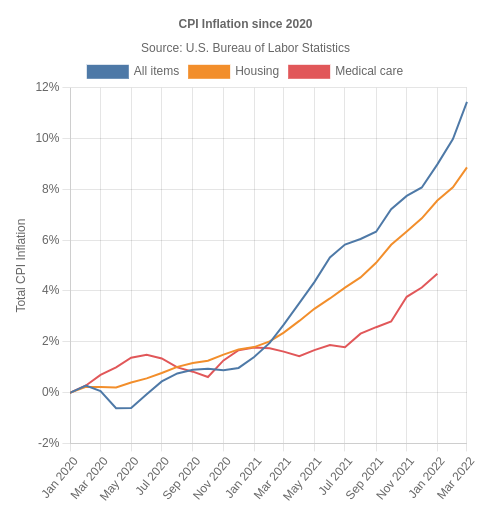Value of $10 from 1930 to 1925
$10 in 1930 is equivalent in purchasing power to about $10.48 in 1925, a difference of $0.48 over 5 years. The dollar had an average deflation rate of -0.93% per year since 1925, producing a cumulative price change of 4.79%.
This means that prices in 1925 are 1.05 times as high as average prices since 1930, according to the Bureau of Labor Statistics consumer price index.
The inflation rate in 1925 was 2.34%. The inflation rate in 1930 was -2.34%. The 1930 inflation rate is lower compared to the average inflation rate of 3.16% per year between 1930 and 2025.
| Cumulative price change | 4.79% |
| Average inflation rate | -0.93% |
| Converted amount $10 base | $10.48 |
| Price difference $10 base | $0.48 |
| CPI in 1930 | 16.700 |
| CPI in 1925 | 17.500 |
| Inflation in 1925 | 2.34% |
| Inflation in 1930 | -2.34% |
| $10 in 1930 | $10.48 in 1925 |
Buying power of $10 in 1925
This chart shows a calculation of buying power equivalence for $10 in 1925 (price index tracking began in 1635).
For example, if you started with $10, you would need to end with $10.48 in order to "adjust" for inflation (sometimes refered to as "beating inflation").
According to the Bureau of Labor Statistics, each of these USD amounts below is equal in terms of what it could buy at the time:
This conversion table shows various other 1925 amounts in 1930 dollars, based on the 4.79% change in prices:
| Initial value | Equivalent value |
|---|---|
| $1 dollar in 1925 | $0.95 dollars in 1930 |
| $5 dollars in 1925 | $4.77 dollars in 1930 |
| $10 dollars in 1925 | $9.54 dollars in 1930 |
| $50 dollars in 1925 | $47.71 dollars in 1930 |
| $100 dollars in 1925 | $95.43 dollars in 1930 |
| $500 dollars in 1925 | $477.14 dollars in 1930 |
| $1,000 dollars in 1925 | $954.29 dollars in 1930 |
| $5,000 dollars in 1925 | $4,771.43 dollars in 1930 |
| $10,000 dollars in 1925 | $9,542.86 dollars in 1930 |
| $50,000 dollars in 1925 | $47,714.29 dollars in 1930 |
| $100,000 dollars in 1925 | $95,428.57 dollars in 1930 |
| $500,000 dollars in 1925 | $477,142.86 dollars in 1930 |
| $1,000,000 dollars in 1925 | $954,285.71 dollars in 1930 |
Inflation by City
Inflation can vary widely by city, even within the United States. Here's how some cities fared in 1930 to 1925 (figures shown are purchasing power equivalents of $10):
- Boston, Massachusetts: -0.11% average rate, $10 → $9.94, cumulative change of -0.57%
- New York: -0.22% average rate, $10 → $9.89, cumulative change of -1.08%
- San Francisco, California: -0.41% average rate, $10 → $9.79, cumulative change of -2.06%
- Seattle, Washington: -0.54% average rate, $10 → $9.73, cumulative change of -2.68%
- Houston, Texas: -0.73% average rate, $10 → $9.64, cumulative change of -3.58%
- Chicago, Illinois: -0.73% average rate, $10 → $9.64, cumulative change of -3.59%
- Philadelphia, Pennsylvania: -0.74% average rate, $10 → $9.64, cumulative change of -3.65%
- Detroit, Michigan: -1.06% average rate, $10 → $9.48, cumulative change of -5.19%
- Atlanta, Georgia: -1.15% average rate, $10 → $9.44, cumulative change of -5.61%
Boston, Massachusetts experienced the highest rate of inflation during the 5 years between 1925 and 1930 (-0.11%).
Atlanta, Georgia experienced the lowest rate of inflation during the 5 years between 1925 and 1930 (-1.15%).
Note that some locations showing 0% inflation may have not yet reported latest data.
Inflation by Country
Inflation can also vary widely by country. For comparison, in the UK £10.00 in 1930 would be equivalent to £10.75 in 1925, an absolute change of £0.75 and a cumulative change of 7.51%.
In Canada, CA$10.00 in 1930 would be equivalent to CA$10.00 in 1925, an absolute change of CA$0.00 and a cumulative change of 0.00%.
Compare these numbers to the US's overall absolute change of $0.48 and total percent change of 4.79%.
Inflation by Spending Category
CPI is the weighted combination of many categories of spending that are tracked by the government. Breaking down these categories helps explain the main drivers behind price changes.
This chart shows the average rate of inflation for select CPI categories between 1930 and 1925.
Compare these values to the overall average of -0.93% per year:
| Category | Avg Inflation (%) | Total Inflation (%) | $10 in 1925 → 1930 |
|---|---|---|---|
| Food and beverages | 0.00 | 0.00 | 10.00 |
| Housing | 0.00 | 0.00 | 10.00 |
| Apparel | -1.76 | -8.49 | 9.15 |
| Transportation | 0.00 | 0.00 | 10.00 |
| Medical care | 0.00 | 0.00 | 10.00 |
| Recreation | 0.00 | 0.00 | 10.00 |
| Education and communication | 0.00 | 0.00 | 10.00 |
| Other goods and services | 0.00 | 0.00 | 10.00 |
The graph below compares inflation in categories of goods over time. Click on a category such as "Food" to toggle it on or off:
For all these visualizations, it's important to note that not all categories may have been tracked since 1930. This table and charts use the earliest available data for each category.
How to calculate inflation rate for $10, 1925 to 1930
Our calculations use the following inflation rate formula to calculate the change in value between 1925 and 1930:
Then plug in historical CPI values. The U.S. CPI was 16.7 in the year 1930 and 17.5 in 1925:
$10 in 1930 has the same "purchasing power" or "buying power" as $10.48 in 1925.
To get the total inflation rate for the 5 years between 1925 and 1930, we use the following formula:
Plugging in the values to this equation, we get:
Data source & citation
Raw data for these calculations comes from the Bureau of Labor Statistics' Consumer Price Index (CPI), established in 1913. Price index data from 1774 to 1912 is sourced from a historical study conducted by political science professor Robert Sahr at Oregon State University and from the American Antiquarian Society. Price index data from 1634 to 1773 is from the American Antiquarian Society, using British pound equivalents.
You may use the following MLA citation for this page: “$10 in 1930 → 1925 | Inflation Calculator.” Official Inflation Data, Alioth Finance, 10 May. 2025, https://www.officialdata.org/1930-dollars-in-1925?amount=10.
Special thanks to QuickChart for their chart image API, which is used for chart downloads.
| Cumulative price change | 4.79% |
| Average inflation rate | -0.93% |
| Converted amount $10 base | $10.48 |
| Price difference $10 base | $0.48 |
| CPI in 1930 | 16.700 |
| CPI in 1925 | 17.500 |
| Inflation in 1925 | 2.34% |
| Inflation in 1930 | -2.34% |
| $10 in 1930 | $10.48 in 1925 |

